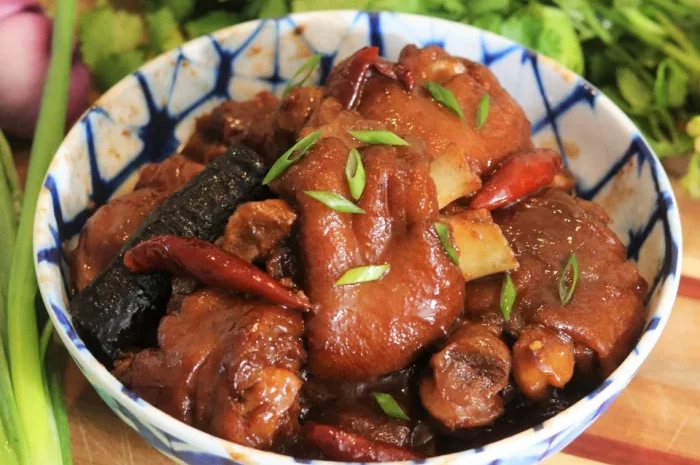In the rich tapestry of Chinese cuisine, few dishes evoke as much nostalgia and culinary heritage as braised pork trotters. A quintessential comfort food, this hearty dish combines tender pork trotters with aromatic spices and savory sauces, resulting in a meltingly tender and deeply flavorful delicacy.
In this comprehensive guide, we’ll explore the time-honored tradition of Chinese braised pork trotters and learn how to prepare this beloved dish right in your own kitchen.
Exploring the Culinary Heritage of Braised Pork Trotters
Braised pork trotters, known as “zhu jiao” in Mandarin, have been a cherished part of Chinese culinary culture for centuries. This dish holds a special place in Chinese cuisine, often enjoyed during festive occasions, family gatherings, and celebratory feasts. The art of braising pork trotters is steeped in tradition, with each region and household adding its own unique touch to the recipe.
Unraveling the Flavor Profile
At the heart of Chinese braised pork trotters lies a rich and complex flavor profile that tantalizes the taste buds and comforts the soul. The key ingredients and seasonings that contribute to this distinctive taste include:
1. Pork Trotters:
The star of the dish, pork trotters provide a gelatinous richness and succulent texture that is deeply satisfying.
2. Aromatics:
Garlic, ginger, and green onions form the aromatic base of the dish, infusing the meat with layers of fragrance and depth.
3. Soy Sauce:
Dark soy sauce adds depth of color and savory umami notes to the braising liquid, imparting a rich and savory flavor to the pork trotters.
4. Shaoxing Wine:
This traditional Chinese cooking wine adds a subtle sweetness and depth of flavor to the dish, enhancing the overall complexity.
5. Spices:
Star anise, cinnamon, and bay leaves lend warm, earthy undertones to the braising liquid, infusing the pork trotters with aromatic warmth.
Selecting the Right Ingredients
When preparing Chinese braised pork trotters, it’s essential to choose high-quality ingredients to ensure the best results. Here are some tips for selecting the key components of this dish:
1. Pork Trotters:
Opt for fresh, high-quality pork trotters from a reputable butcher or Asian market. Look for trotters that are plump, with firm, white skin and minimal odor.
2. Aromatics:
Choose fresh garlic, ginger, and green onions for the most vibrant and aromatic flavor. Avoid using wilted or bruised aromatics, as they may impart off-flavors to the dish.
3. Soy Sauce and Shaoxing Wine:
Use premium-quality soy sauce and Shaoxing wine for authentic flavor. Look for brands that are naturally brewed and free from additives or preservatives.
4. Spices:
Select whole spices whenever possible, as they will impart the freshest flavor to the dish. If using ground spices, opt for high-quality varieties to ensure optimal flavor and aroma.
Mastering the Technique
While braising pork trotters may seem daunting, mastering the technique is well within reach with a few simple steps:
1. Prepare the Trotters:
Start by thoroughly cleaning the pork trotters, removing any hair or debris, and trimming excess fat. Blanch the trotters in boiling water for a few minutes to remove impurities, then rinse them under cold water and pat dry.
2. Sear the Trotters:
Heat a bit of oil in a large pot or Dutch oven over medium-high heat. Add the pork trotters and sear them until golden brown on all sides, locking in flavor and caramelizing the surface.
3. Add Aromatics and Spices:
Add minced garlic, ginger slices, and chopped green onions to the pot, along with whole spices such as star anise, cinnamon, and bay leaves. Stir-fry the aromatics and spices until fragrant, infusing the oil with their flavors.
4. Deglaze with Liquids:
Pour in a mixture of dark soy sauce, Shaoxing wine, and water, deglazing the pot and scraping up any browned bits from the bottom. Bring the liquid to a simmer, then reduce the heat to low.
5. Braise Until Tender:
Cover the pot and let the pork trotters simmer gently in the braising liquid for several hours, until they are fork-tender and the meat is falling off the bone. Skim off any excess fat or impurities that rise to the surface during cooking.
6. Adjust Seasoning:
Taste the braising liquid and adjust the seasoning as needed, adding more soy sauce, salt, or sugar to balance the flavors to your preference.
7. Serve and Enjoy:
Once the pork trotters are tender and infused with flavor, transfer them to a serving dish and garnish with chopped green onions and a sprinkle of white pepper. Serve hot alongside steamed rice or noodles for a comforting and satisfying meal.
Experimenting with Variations
While traditional Chinese braised pork trotters are a classic favorite, there are endless variations and adaptations to explore:
1. Spicy Braised Pork Trotters:
Add dried chili peppers or chili bean paste to the braising liquid for a spicy kick that will awaken the senses.
2. Sweet and Sour Pork Trotters:
Incorporate vinegar and sugar into the braising liquid to create a tangy-sweet flavor profile that balances the richness of the pork trotters.
3. Herb-infused Pork Trotters:
Experiment with different herbs and aromatics such as lemongrass, Thai basil, and cilantro to add a fresh and aromatic twist to the dish.
Conclusion
Chinese braised pork trotters exemplify the artistry and tradition of Chinese culinary heritage, offering a tantalizing blend of flavors and textures that delight the senses and nourish the soul.
By mastering the art of making braised pork trotters, you can experience the joy of creating a time-honored classic right in your own kitchen.
Whether enjoyed as a comforting family meal or shared during festive gatherings, braised pork trotters are sure to leave a lasting impression and create cherished memories for years to come.


























